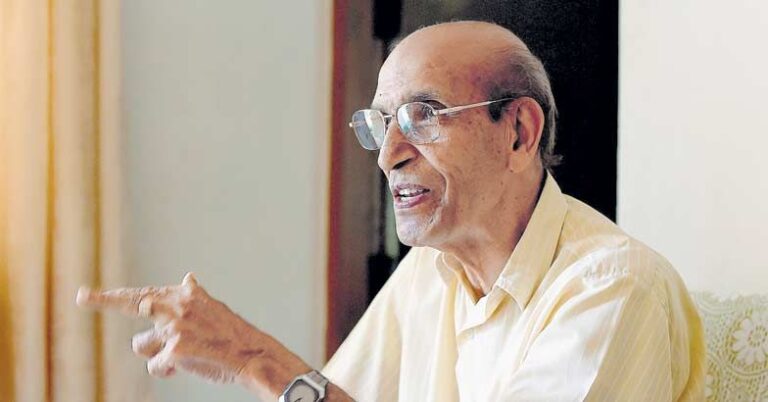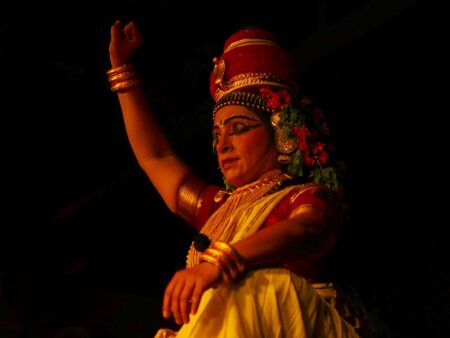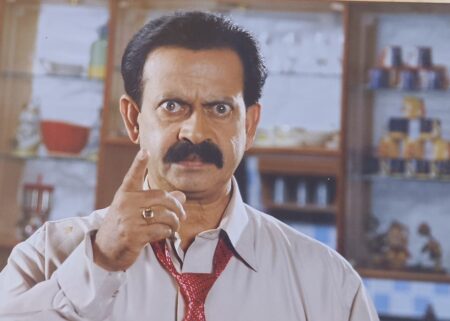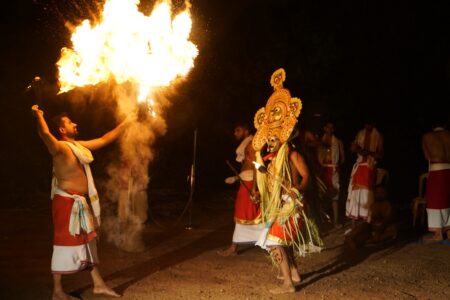Playwright C L Jose has turned 90. A peek into his plays and theater.
C L Jose is a firm believer of the universal axiom, . ‘Lokavrithanukaranam natyam’ (Drama is imitation of life).-Over the past four decades and more he has been ploughing a lone furrow in the century-old Malayalam theatre. His immortal contributions have enriched the amateur theatre of Kerala considerably. Admittedly, the leitmotifs of-his 36 plays, 75 one act plays and one children’s play that have so far appeared in print, have been socially relevant. And that ranged from mercy killing to eviction of hill-settlers in Kerala.
The secret of the wide acceptance of his plays has been nothing else. ‘Manalkkadu’ and ‘Aginivalayam’ have been especially noteworthy and All India Radio broadcast them translated into 14 regional languages. Moreover, Manalkkadu’, `Jwalanam’ and ‘Yugathrishna’ were prescribed as text books by the universities of Kerala for degree classes. A former vice-chairman of Kerala Sangeetha Nataka Akademi, Jose has been honoured by both Kerala Sahithya Akademi and Sangeetha Nataka Akademi for his contributions to literature and theatre.
India Art Review is reproducing an interview with Jose on the story of his evolution as a self-tutored playwright, his giant strides and also the essence of his approach to theatre.
Professionally you were a manager in a finance company. But what was the motivation for theatre?
I was actively involved in theatre right from my student days. I started as a short story writer, But I turned a playwright because of a necessity when the kalasamithy of which I was a member was searching for a play to be staged. Unable to find a suitable one, my friends suggested, “Why don’t you try one; after all you have published many short stories so far.” Consequently, `Maanam thelinju’ was the result, in 1956.
The response to the play staged by the troupe was really overwhelming. And soon followed by the next one, ‘Jeevitham oru kodunkaattu.’ Now it was almost clear to me that I have to take theatre seriously.
How did you enlighten yourself in this area?
I turned a voracious reader of the plays and seized every opportunity to watch those presented by eminent thespians like Thoppil Bhasi, N N Pillai, K T Mohammed, S L Puram Sadanandan and the like who had ruled the roost those days. To be frank, they used to haunt me for days on end. Honestly speaking this was my training in theatre. It came home to me that the seeds of a play lay before my eyes. My observation of events and people around me became keen. You can see them portrayed in my plays.

If drug addiction was the theme in `Meghadwani,’ it was the judiciary in `Manalkkadu.’ While Vishakkattu’ portrayed the picture of a hospital, ‘Kannikkani’ anchored on the much-discussed issue of abortion.
But such specialised topics involve a lot of technical details. How did you learn them?
May I tell you that all such plays have been technically perfect with regard to their respective areas. For, I entered into discussions with professionals of each branch before I made an attempt. I remember having lengthy discussions with the district judge of Thrissur for penning `Manalkkadu,’ Both for `Vishakkattu’ and ‘Ente valiya pizha’ a host of medical professionals were consulted.
What do you think has been the reason for the wide acceptability of your plays?
To be brief, ‘effective communication with the audience.’ Over the years, I could evolve a style of narration that is quite lucid and direct as against the modern plays. The characters I created helped immensely in this.
The end result was that I could touch the psyche of the audience with the same intensity with which a topic had touched me. You know, I used to articulate the dialogue myself before scripting them. Brevity has been the hailtittk’ of my dialogue. A play appeared in print only after the finishing touches, that too after staging it under my direction.
Several directors have attempted your plays. Were you satisfied with them?
Not always. Only those who could get my message in the play have been successful. I believe that the director has a creative role in the production of a play.
What are your impressions about the modern plays?
See most of them with very few exceptions have been merely improvised plays with no script. Moreover, they hardly reflect our esoteric culture, Emphasis is more on the techniques that are unintelligible for the common man. Events of daily life do not find any place in them. But I must admit that certain areas like stagecraft have developed thanks to the emergence of Natakakalaris and School of Drama. But it would appear that a chorus, a sutradhara as in a Sanskrit play, use of chendas etc are inevitable for the production of a play. Regrettably, the amateur theatre copied all these blindly and hence their non-acceptability by the society. Thus, I must add that the School of Drama is totally myopic to the Kerala stage.
Is it not a pity that stalwarts like N N Pillai, K T Mohammed, Thoppil Bhasi and S L Puram were never invited to the School to address the students?
How do you assess the performance of the professional theatre vis-à-vis the amateur?
In the professional theatre of the present day, art is relegated to the back seat. The eye is on the market. That is why cinematic techniques are profusely added. It is the amateur branch that does a lot of experimentation. But their problems are economic. Non-availability of actresses add to their woes.




